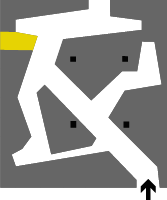Ola Kaare Sindre Hofmo 1905 - 1945 Edit
Born 16.4.1905 in Oslo
Died 23.1.1945 in Gusen
Biography
Ola Hofmo war von Beruf Journalist. Als im August 1940 die Zeitung Arbeideren, für die er tätig war, von den Deutschen verboten wurde, setzte er seine Arbeit als Redakteur in der illegalen Presse fort.
Ab Sommer 1941 musste er versteckt leben. Er wurde eine Schlüsselfigur des Widerstandes gegen die deutsche Besatzungsmacht. Im August 1942 kam es in Oslo in einer groß angelegten Razzia gegen die Widerstandsbewegung zu einem Feuergefecht, bei dem er verwundet und von den Deutschen verhaftet wurde. Nach einem Jahr Haft unter sehr strengen Bedingungen in einem Gefängnis in Oslo wurde er als „Nacht-und-Nebel“-Häftling ins Konzentrationslager Natzweiler deportiert. Dort kam er am 10. September 1943 an, erhielt die Häftlingsnummer 5068 und blieb, bis das Lager im September 1944 evakuiert wurde. Nach einem kurzen Aufenthalt im Konzentrationslager Dachau wurde er am 16. September 1944 ins Konzentrationslager Mauthausen überstellt, wo er die Häftlingsnummer 98246 erhielt. Am 5. November 1944 wurde er weiter ins Außenlager Gusen II gebracht.
Olas ältere Schwester, Solveig Hofmo Smedsrud, war im April 1942 unter dem Verdacht verhaftet worden, ihren Bruder versteckt zu haben. Über Grini, Ravensbrück und Auschwitz kam sie Anfang März 1945 ebenfalls nach Mauthausen. Am 17. März wurde Solveig Hofmo Smedsrud gemeinsam mit einer anderen Norwegerin, Gudbjørg Skaug, ins Lager Bergen-Belsen weitertransportiert. Gudbjørg wurde dort registriert, verschwand aber später. Solveig kam nie an und wurde nie wieder gefunden.
Ola Hofmo war von Natur aus ein ruhiger, nachdenklicher und hilfsbereiter Mensch.
Während der unmenschlichen Umstände, unter welchen die Häftlinge in der Gefangenschaft lebten, kamen diese Eigenschaften auch seinen Mithäftlingen zu Gute. Einer von ihnen beschrieb später, wie Ola versucht hatte, die Lage der schwächsten Mitgefangenen zu erleichtern. Wir zitieren aus dem Bericht, der nach dem Krieg erstellt wurde und darüber erzählt: „Es ist bitter, darüber nachzudenken, dass gerade er, der das Leben von so vielen anderen gerettet hatte, sein eigenes verlieren sollte, denn er war einer derer, auf die man am schwersten verzichten kann.“[1]
Ola kam am 23. Jänner 1945 in Gusen II ums Leben. Er hinterließ eine Ehefrau und zwei Kinder.
Per und Inger Hofmo
Per und Inger Hofmo sind Sohn und Tochter von Ola Kaare Sindre Hofmo.
Aus dem Norwegischen von Lykke Larsen und Merethe Aagaard Jensen
[1] Archiv des Norges Hjemmefrontmuseum (Norwegisches Widerstandsmuseum), 43 C, Box C, Sammlung Siggen Olsen, Bericht von Mogens Kielland.
Ola Hofmo was a journalist by profession. When, in August 1940, the Arbeideren newspaper for which he worked was banned by the Germans, he continued to work as an editor for the underground press.
From summer 1941 onwards he had to go into hiding. He became a key figure in the resistance movement against the German occupying forces. In August 1942, during a large-scale raid against the resistance movement in Oslo, shooting took place during which he was injured and captured by the Germans. After one year’s imprisonment under very harsh conditions in a prison in Oslo he was deported to the Natzweiler concentration camp as a Nacht-und-Nebel (‘Night and Fog’) prisoner. He arrived there on 10 September 1943, was assigned prisoner number 5068 and remained there until the camp was evacuated in September 1944. After a short time at the Dachau concentration camp, on 16 September 1944 he was transferred to Mauthausen concentration camp, where he was given prisoner number 98246. On 5 November 1944 he was taken on to the Gusen II subcamp.
Ola’s older sister, Solveig Hofmo Smedsrud, had been arrested in April 1942 under suspicion of hiding her brother. Via Grini, Ravensbrück and Auschwitz, she also came to Mauthausen, arriving at the beginning of March 1945. On 17 March, Solveig Hofmo Smedsrud and another Norwegian women, Gudbjørg Kaug, were sent on a transport to the Bergen-Belsen camp. Gudbjørg was registered there but later vanished. Solveig never arrived and was never seen again.
Ola Hofmo was a quiet, thoughtful and helpful person by nature. Under the inhuman conditions in which the prisoners lived, his fellow inmates also benefited from these qualities. One of them later described how Ola tried to make things easier for the weakest inmates. The following quote is taken from a report compiled after the war which tells of this: ‘It is bitter to think that the very person who had saved the lives of so many others should lose his own, for he was one of those whom it is hardest to relinquish.’[1]
Ola died on 23 January 1945 in Gusen II. He left behind a wife and two children.
Per and Inger Hofmo
Translation into English: Joanna White
[1] Report by Mogens Kielland (Archive of the Norges Hjemmefrontmuseum [Norwegian Resistance Museum], 43 C, Box C, Collection Siggen Olsen).
Send information about this person...
